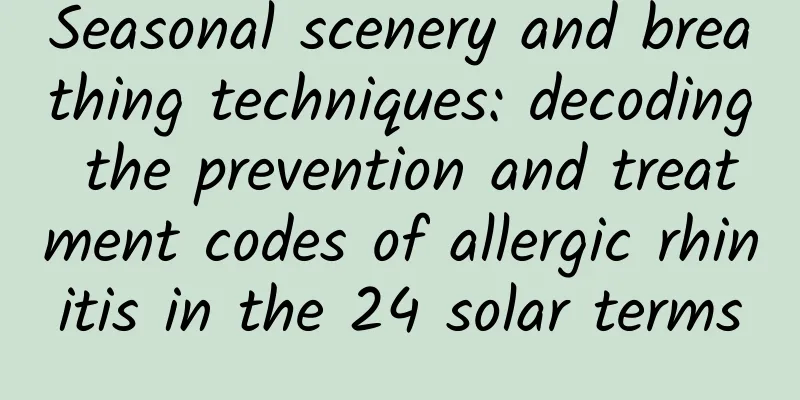Seasonal scenery and breathing techniques: decoding the prevention and treatment codes of allergic rhinitis in the 24 solar terms

|
Author: Zhang Ruxiang, attending physician, Beijing Friendship Hospital, Capital Medical University Reviewer: Ma Youxiang, Chief Physician, Beijing Friendship Hospital, Capital Medical University When the gentle spring breeze brushes across people's cheeks, it brings a touch of warmth and also blows away the flying pollen; when the summer rain falls, mold will quietly and silently begin to grow in the humid air; when the autumn wind blows, the fallen leaves flutter down, and the dry environment allows dust mites to run rampant; when the winter snow covers the earth, the cold air constantly stimulates the sensitive nasal cavity... I wonder if you will have an itchy nose, sneezing continuously, running nose, and feel that your nose is sealed by "cement"? I wonder if you are suffering from allergic rhinitis? Around the world, about 20% of adults and 40% of children are suffering from allergic rhinitis, and the incidence rate in my country is roughly at the same level. This disease may seem like a small problem on the surface, but it has a serious impact on our quality of life. It can make our breathing difficult and difficult to fall asleep, and may also cause a series of related diseases such as allergic conjunctivitis, asthma, and sinusitis. This annoying rhinitis is closely related to the rotation of seasons. By carefully studying the wisdom of our ancestors - the 24 solar terms, we can explore the laws of the spread of many allergens and deal with them calmly. What is allergic rhinitis? Allergic rhinitis, as the name suggests, means that our nose is "oversensitive" to certain substances. These substances are called allergens. Common allergens include pollen, dust mites, mold, animal dander, etc. When our nasal mucosa comes into contact with these allergens, the immune system will "overreact" and release inflammatory mediators such as histamine, causing edema or congestion of the nasal mucosa, and symptoms such as nasal itching, sneezing, runny nose, and nasal congestion. Figure 1 Original copyright image, no permission to reprint The love-hate relationship between the 24 solar terms and allergic rhinitis Generally speaking, allergens are not pollutants, but products of nature, which conform to the laws of nature. For example, we call allergic rhinitis that occurs in spring and autumn hay fever, and the culprit is plant pollen. The ancients divided the year into 24 periods based on the annual movement of the sun, which were called the 24 solar terms to describe the unique climate characteristics of different seasons. These climate changes directly affect the types, concentrations and transmission methods of allergens in nature. There are several solar terms in spring, including the Beginning of Spring, Rain Water, Waking of Insects, Spring Equinox, Qingming Festival, and Grain Rain. Spring is back and everything is revived, but for patients with allergic rhinitis, this is a "troublesome spring". In northern my country, spring is the peak season for pollen allergies. Since the Waking of Insects, pollen from trees such as poplars, willows, and elms has been flying all over the sky and penetrating every hole under the blowing of the spring breeze. Pollen release reaches its peak from the Spring Equinox to Grain Rain. Around the Beginning of Summer, the flowering period of trees ends and the pollen concentration gradually decreases. The following suggestions are given: Pay close attention to the pollen concentration forecast and try to avoid long-term outdoor activities during the peak pollen period. Wear anti-pollen masks (or N95 masks), glasses and other protective equipment when going out. Clean the pollen on clothes and hair before going home and enter the room, and rinse the nasal cavity with saline, wash your face and rinse your mouth. Keep the room clean and use an air purifier when necessary to reduce the indoor pollen concentration. For those who regularly experience allergic symptoms every spring, you can use nasal spray corticosteroids or antihistamines 2 weeks in advance to have a preventive effect. In southern my country, spring comes earlier than in the north. After the beginning of spring, some early-flowering trees begin to release pollen. During the period from Jingzhe to Qingming, pollen from multiple plants is released at the same time. However, due to the wide variety of plant species in the south and the staggered flowering periods, the peak of pollen is relatively scattered, not as concentrated as in the north. Most plants will end their flowering period around the Grain Rain. The south is warm and humid. In addition to pollen, mold is also a major allergen. When the south wind returns, mold may grow on walls and furniture, releasing a large number of spores and causing allergic symptoms. The following suggestions are given: Keep the room clean, focusing on cleaning areas where mold is prone to grow, such as bathrooms and kitchens. Ventilate frequently to reduce indoor humidity and reduce mold growth. Use an air purifier to filter allergens in the air. Summer includes the beginning of summer, the grain-filling season, the grain-in-ear season, the summer solstice, the minor heat, and the major heat. In summer, the weather is hot and rainy. Although the pollen concentration decreases at this time, mold and dust mites have ushered in a period suitable for their growth and reproduction. A humid environment can provide good conditions for the growth of mold. Places such as air conditioning filters, bathrooms, and kitchens may become places where mold gathers and grows. During the rainy season before and after the summer solstice, the concentration of mold spores will increase rapidly; dust mites prefer to live in warm and humid bedding, carpets, and sofas. The high temperature and high humidity environment in summer creates very good conditions for the reproduction of dust mites. In view of this, the following suggestions are given: clean the air conditioning filter regularly to keep the room dry and ventilated, wash and dry the bedding frequently, use anti-mite bedspreads, try to avoid using carpets, plush toys and other items that are easy to breed dust mites, and use dehumidifiers to reduce indoor humidity. Autumn involves the solar terms of Beginning of Autumn, End of Heat, White Dew, Autumnal Equinox, Cold Dew, and Frost Descent. The weather in autumn is sunny and dry, but the weather is relatively dry. For patients with allergic rhinitis, this is another difficult season. In northern regions, autumn is the peak period for the spread of weed pollen such as wormwood and ragweed. These pollen particles are relatively small and can easily enter the respiratory tract and cause allergic symptoms. Around the Beginning of Autumn, as the rainy season ends and the temperature becomes suitable, weeds begin to bloom and release pollen. From the End of Heat to the Autumnal Equinox, pollen from multiple weeds will be released at the same time, reaching a peak state. Around Frost Descent, as the temperature drops, weeds wither and pollen concentrations gradually decrease. In southern regions, the climate in the south is warm and humid in autumn, and many plants can still grow, but the pollen concentration is generally low, and there is no very prominent peak period. It should be noted that the concentration of mold spores in the south may be relatively high in autumn, which is also a key allergen. The suggestions given are as follows: Just like in spring, pay attention to pollen concentration, take appropriate protective measures, keep the room clean to reduce the breeding of dust mites, and pay attention to keeping warm to avoid irritation of the nasal cavity caused by cold air. Winter includes the beginning of winter, light snow, heavy snow, winter solstice, minor cold, and major cold. Winter weather is cold and dry, and there are relatively few types of allergens, but cold air itself is a factor that can cause irritation. Cold air can irritate the nasal mucosa, causing blood vessels to contract, the mucosa to become dry, and the defense function to decrease, which can easily induce allergic rhinitis. Indoor heating in winter will cause the air to become dry, and the indoor humidity will be less than 30%. However, the microenvironment of bedding still maintains a humidity of 55%, becoming a "refuge" for dust mites, which are more likely to breed. Closed doors and windows and poor air circulation can also easily lead to increased allergen concentrations. The following suggestions are given: pay attention to keeping warm, wear a mask when going out, avoid direct irritation of the nasal cavity by cold air, keep the room ventilated, open windows for ventilation every day, use a humidifier to increase indoor humidity, and regularly clean heating equipment to reduce the growth of dust mites and mold. Change bedding and clothes in time, and hang clothes out to dry or wash them in warm water to remove most mites. It can also reduce the food source of mites by removing dust and dandruff on the surface of clothes. Common treatments for allergic rhinitis Allergic rhinitis is difficult to cure, but with the help of standardized treatment, the symptoms can be effectively controlled and the quality of life can be improved. Commonly used drugs include the following: Nasal glucocorticoids, as the first-line drug for the treatment of allergic rhinitis, can reduce nasal inflammation and relieve symptoms such as nasal congestion, runny nose and sneezing. Antihistamines, also a first-line drug for the treatment of allergic rhinitis, can relieve nasal itching, sneezing and runny nose. Nasal irrigation, using saline or sea salt water to rinse the nasal cavity, can remove allergens and inflammatory secretions in the nasal cavity, reduce nasal mucosal edema, and has a preventive effect on allergic rhinitis, and can also have a certain therapeutic effect. Figure 2 Original copyright image, no permission to reprint In recent years, immunotherapy has made breakthrough progress. For patients with rhinitis whose main allergens are house dust mites, dust mites and Artemisia annua pollen, desensitization therapy can not only effectively control allergic symptoms, but also change the natural course of the disease and prevent allergic rhinitis from developing into asthma. With the development of precision medicine, new targeted biological agents targeting specific cytokines involved in the allergic inflammatory process (such as immunoglobulin IgE and interleukins IL-4, IL-5, IL-13) have entered clinical application, providing a new effective treatment option for patients with moderate to severe allergic rhinitis. Traditional Chinese medicine has unique advantages in treating allergic rhinitis: Evidence-based medicine shows that classic prescriptions such as Yupingfeng Powder can effectively improve rhinitis symptoms; acupuncture and acupoint application can reduce nasal resistance and improve nasal ventilation, and are effective means of treating allergic rhinitis. Avoiding contact with allergens is the most fundamental way of prevention. With the help of allergen testing, you can identify your own allergens and then try to avoid contact. It should be noted that the above treatment methods are for reference only, and specific medications must be taken according to the doctor's advice. Conclusion: Wisdom of coping with rhinitis Allergic rhinitis is difficult to cure completely, but by understanding its relationship with the 24 solar terms and mastering the prevention and treatment methods in different seasons, you can effectively control symptoms, reduce the number of attacks, and make life easier. In the change of the 24 solar terms, follow the laws of nature and adjust your lifestyle. Don't be stubborn when you need to take medicine, and don't be bothered when you need to take precautions. Take action to protect your respiratory health and win the "protracted battle" with allergic rhinitis. No longer troubled by runny nose and nasal congestion, breathe fresh air freely and happily. |
<<: Understand chronic sinusitis and win the battle to protect your nasal cavity!
>>: What happens if protein is deposited in the alveoli? How to treat it?
Recommend
Breast cancer symptoms and treatments
The symptoms of breast cancer can be varied, the ...
How do stretch marks come about?
Stretch marks are a skin condition that most fema...
The secret to a quick birth
After becoming pregnant, women have to consider w...
What to do if the incision hurts after cesarean section
More and more women choose cesarean section when ...
Brown discharge during pregnancy
As we all know, women will take adequate preparat...
What should pregnant women do if they eat pepper?
As a pregnant woman, it is best not to eat pepper...
The battle against fat: Can "Glutide" really help you realize your dream of losing weight while lying down?
Milk tea, hot pot, barbecue, sumptuous New Year&#...
Why does a pregnant woman feel bitter in her mouth when she wakes up in the morning?
After a woman becomes pregnant, she undergoes tre...
What is the cause of watery leucorrhea and vulvar itching?
Various gynecological problems have brought a lot...
Is it good for women to drink Astragalus extract?
Due to women's special physiological phenomen...
[Fat Bear Science] Precancerous lesions, when these diseases appear, they may be a sign of cancer
Although some lesions are not malignant tumors th...
What are the symptoms before menstruation?
At a certain stage, women may experience menopaus...
What is labia fissure?
If a woman finds that there are cracks on both si...
Can a person with thalassemia have a baby?
Thalassemia is a relatively rare disease with a l...









